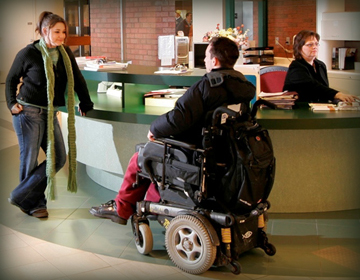

Practice: Serving People with Disabilities Exercise 1 How should Samita greet these visitors?
Take a moment to consider the situation. Click on the correct response. After receiving the feedback, click on the other two options for more information. |
 |
| CC On | CC Off | Resources | Map | Back | Next | Audio Player: |
Exercise 1
Samita works at the campus Welcome Centre. One day while she is working, two people approach the desk – a woman with a developmental disability and a man who introduces himself as her support person.
How should Samita greet these visitors?
Take a moment to consider the situation. Click on the correct response. After receiving the feedback, click on the other two options for more information.
Turn to the support person and say “Welcome to the college. How can I help you?” (click here to close this box)
A friendly greeting is a good start. But you should speak directly to the person with the disability, not the support person. The support person is there to help but it is the client with the disability who is the person being served.
Turn to the person with the disability and say “Oh, so you are a special needs visitor. I'll get someone to help you right away.” (click here to close this box)
Greeting the person with the disability this way is not appropriate. This greeting is likely to make the person with the disability feel singled-out as someone who is different. People with disabilities should be made to feel just as welcome as anyone else.
There should be no need to get help from someone else to offer customer service to a person with a disability. You should be confident that you can provide the appropriate service to customers with disabilities. If you are still unsure, ask your supervisor for more information.
The correct greeting in this situation is to welcome the individual with the disability directly and offer assistance.
Turn to the individual with a disability and say “Welcome to the college. How can I help you?” (click here to close this box)
Welcoming person directly and offering assistance is the correct action. The support person is there to provide assistance but it is the person with a disability who is your client and deserves your direct attention.